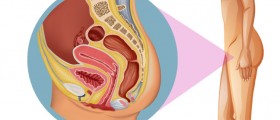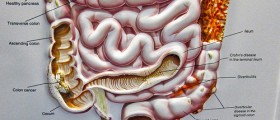
Endometrial (uterine) polyps are benign growths affecting the inner wall of the uterus and growing inside its cavity. These benign tumors develop due to overgrowth of the endometrial cells. Some women suffer from rather small uterine polyps while in others the tumor may reach the size of a golf ball. No matter what the size of uterine polyps is, they are all attached to the uterine wall by a large base or a thin stalk. It is also possible to have one or suffer from multiple uterine polyps. Such growths are commonly found in women in their reproductive years, especially women in their 40s and 50s.
Endometrial Polyps Clinical Characteristics
Small endometrial polyps are asymptomatic and never cause any health problems. Larger ones, on the other hand, may be a cause of different sensations and symptoms.
The very presence of the polyp inside the uterus may be (and usually is) associated with irregular menstrual bleeding (frequent or unpredictable periods, heavy period or even prolonged bleeding), bleeding between menstrual periods, vaginal bleeding in postmenopausal women and fertility issues.
It does not matter whether polyps are the underlying cause of vaginal bleeding after menopause, bleeding between menstrual period or irregular menstrual bleeding, all of the mentioned must be reported as soon as possible to a well experience gynecologist.
Causes of Endometrial Polyps
The underlying cause of endometrial polyps remains a mystery. Still, many doctors believe that specific hormonal changes represent trigger factors for the development of these benign tumors. Uterine polyps are, for instance, estrogen-sensitive, meaning that they respond to estrogen and if there is excess of estrogen in the body, they will grow extensively.Diagnosing Endometrial Polyps
It is not possible to diagnose uterine polyps by gynecological exam only. Doctors need to perform additional exams. Transvaginal ultrasound is a non-invasive procedure that can successfully visualize uterine polyps. Hysteroscopy is a bit more invasive. It includes insertion of a thin and flexible, lighted telescope into the uterus. After this is done, the doctor examines inside of the uterus and may at the same time remove polyps if they are present.
Curettage is a procedure which includes scraping of the suspicious tissue with an instrument containing a loop on one end. The procedure allows collecting a specimen for further analysis and it may also be done to remove the entire polyp.
Endometrial Polyps Treatment Options
Many uterine polyps may peel spontaneously. This is why doctors initially recommend watchful waiting. Furthermore, the size of the growth can be successfully reduced with some drugs such as progestins and gonadotropin-releasing hormone agonists. Curettage removes the tumor completely. It is usually performed during hysteroscopy. Finally, hysterectomy is reserved only for the polyps which have been pathohistologically confirmed to be malignant, especially if the disease has significantly progressed.

















Your thoughts on this
Loading...